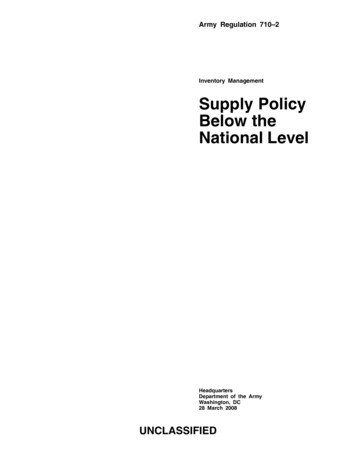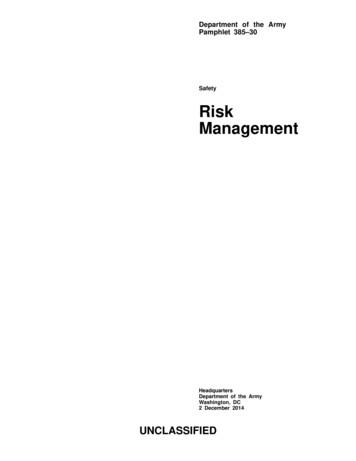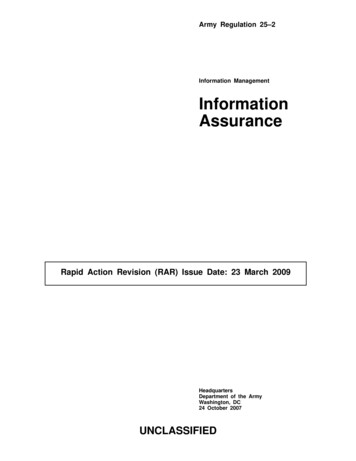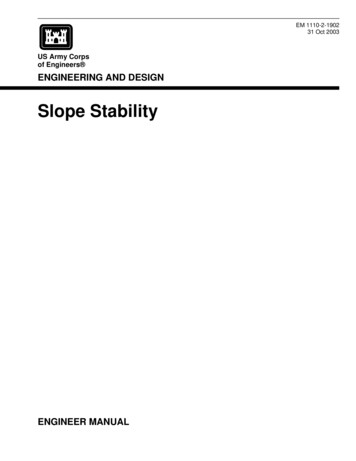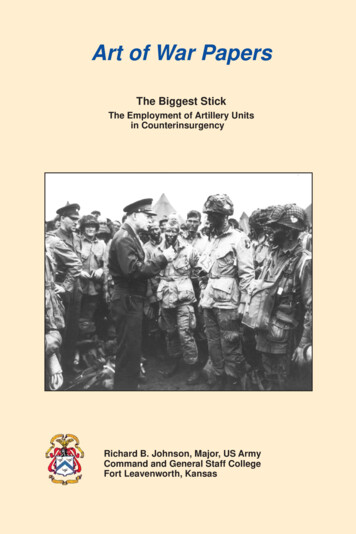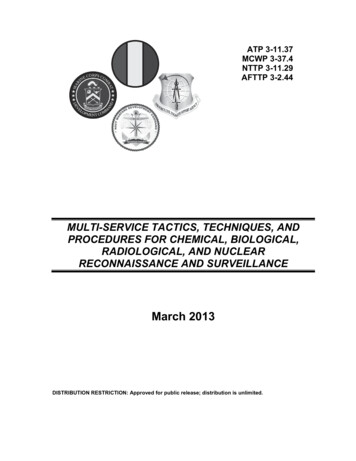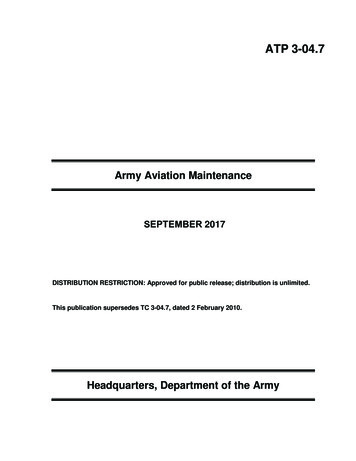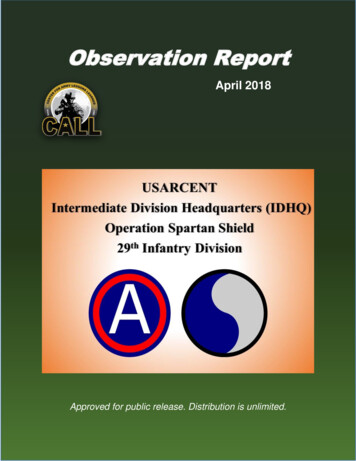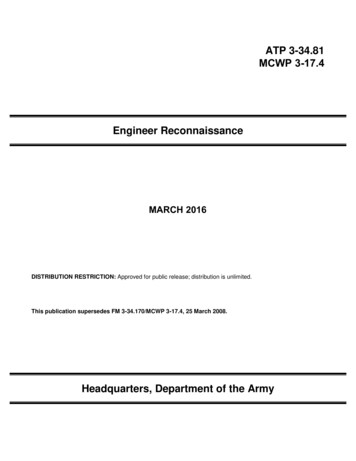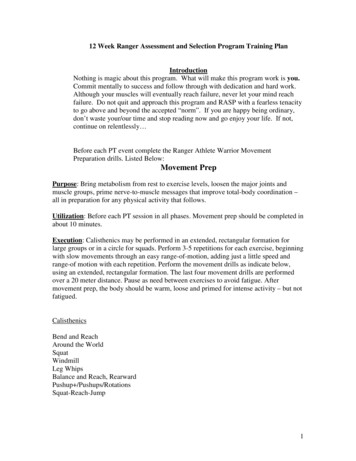
Transcription
SupplyManagement
"Withoutsupplies, neither ageneral nor a soldier is goodfor anything."Clearchus of Sparta(About 400 BC)
The ProblemThe basic challenge for supply management is to provideSoldiers with the necessary support while also minimizingwasteful practices.The Army requires all varieties of equipment, from completeweapons systems, to individual items, and repair parts. It isthe job of Quartermaster personnel to provide this material tothe Soldiers.Yet supplies cost money, and the Army cannot afford to wastemoney. If the Army allows waste it is not only a betrayal ofthe taxpayers’ trust, but it limits the money available forneeded supplies.
Sources of Avoidable CostsNegligent loss ordamage ofgovernment propertyis the most obviouscause of waste. Thiscan range fromcarelessly allowingtheft of governmentproperty, damage toequipment through improper operation, or just simply losingitems. Every Soldier is trained from the beginning of his/her totreat government property in a responsible manner.Yet excessive inventory is another cause of waste in thegovernment. Unnecessary supplies in storage ties up moneythat might be used for other purposes. It also costs money forwarehousing. When items in storage exceed their shelf life orbecome obsolete, the government loses that investment.Tactically, excessive inventory limits the movement of theunits.
The history of the Armysupplyfunction is that ofgiving the Soldiers whatthey need,while controlling theavoidable costs.
Accountability andResponsibilityThere is a difference between accountability and responsibility.Accountability involves the duty to maintain accurate recordsfor government property. This might be unit property (usuallytracked using a property book) or a warehouse or some othersupply activity (usually tracked using a stock record account).Responsibility is the duty to safeguard government propertywithin one’s control. This might be supervisory responsibility,such as a company commander. It might include personalresponsibility for the individual Soldier and his/her individualequipment.Either role can involve financial liability in the event ofnegligence.
Financial LiabilityThe best way to keep a Soldierinterested in protecting governmentproperty is to hold that individualresponsible. If the property is missingthe individual needs to provide anacceptable explanation or pay for the item.Throughout its history the Army has used the prospectof losing money to keep its personnel interested inprotecting government property. Often rules could bevery strict.
Washington’s ArmyFinancial liability began as early as theAmerican Revolution when theContinental Army became concernedabout the loss of tools.In 1776 George Washington’s GeneralOrders stated that officers would pay forthe loss of tools. Enlisted personnelmight have the cost deducted from their pay and be“punished according to the nature of the offense.”
Property Book vs Stock RecordEssentially the Army has two forms of property accountability:the unit property book and the stock record account.The property book records the non-expendable propertyassigned to a unit or organization. It might include itemsranging from vehicles to computers. Quantities seldom changeunless the item is lost or damaged, or unless there is a newissue. Usually a company commander is responsible for theproperty in his/her company, but the commander can directsubordinates to sign for property.Within the Army we have different types of supply activities.These are organizations that store and issue different types ofsupplies, usually working out or a warehouse or a field storagesite. These supplies can range include individual clothing,repair parts, or just about anything else. New items arrive, goto the shelves, and then are issued out. The quantity isexpected to fluctuate. The Army uses the stock record accounttells the user is on hand compared to what should be on handbased on the number of demands.
Evolution ofthe Army SupplySystem
Early ArmySoldiers during the early years of the Army frequently sufferedfrom a faulty or non-existent supply system. Most Americansare familiar with the stories of the Revolutionary War Soldierswho fought without proper uniforms or equipment, frequentlywithout shoes.After the Revolution, Congress abolished the position ofQuartermaster General, reasoningit was a wartime only position.When Congress did try to reestablish the office just before theWar of 1812, it was too late tocreate an effective supply system.Again the Soldiers suffered.After the war, Congress tried two Quartermaster Generals, onefor the Northern Department and one for the SouthernDepartment.Finally in 1818 Congress created a single QuartermasterDepartment for the entire Army, with one QuartermasterGeneral.
Thomas JesupFather of the Quartermaster CorpsFrom 1818 to 1860 Thomas Jesupserved as the QuartermasterGeneral. During the War of 1812he was an Infantry officer, so heunderstood the meaning of badsupport. During his lengthy tenurehe created an effective supplyorganization. His work includedthe ever present paperwork thataccompanied all propertytransactions.Jesup established two principles that remain relevant to allQuartermasters. The work of the Quartermaster is first amilitary function. The work must be oriented towardsupporting victory. His second principle was that allQuartermasters are accountable stewards of governmentmoney and property. Except at the cost of compromisingmilitary operations, this is a duty of the Quartermaster Soldiersand civilians.
Nineteenth CenturyJesup’s initiatives established the foundations for successduring the rest of the century, although with some difficulties.The rapid mobilization of the Civil War created chaos for thefirst months, until order could be re-established. In time theQuartermasters became quite effective at supporting massivearmies; but the expertise quickly disappeared as the Armytransitioned to the Indian Wars. Then in 1898, a minor warwith Spain over the future of Cuba proved to be a majorembarrassment for Army logisticians.From 1818 to 1912 the Army employed a QuartermasterDepartment rather than a Quartermaster Corps. As adepartment it relied upon government civilians andcontractors to do much of the work later performed bySoldiers. Also the Quartermaster Department did notpurchase food items.
Quartermaster CorpsIn 1912 the QuartermasterDepartment became theQuartermaster Corps. Up to thistime the QuartermasterDepartment consisted of relativelyfew military personnel. Most of theactual labor of logistical work was performed by governmentcivilians or contractors. The Quartermaster hired and paid theworkforce.With the conversion to a Quartermaster Corps, the Army couldorganize units of Soldiers to perform this work, includingoperating supply points. At the same time, the QuartermasterCorps also became responsible for purchasing and deliveringsubsistence.Like other Soldiers within the Army, Quartermaster Soldierswere becoming more professional. The school in Philadelphiabecame the beginning of what is now the QuartermasterSchool. The job of supplying Soldiers was no longer somethingjust learned on the job.
World War IBy the close of World War I theQuartermaster Corps wassupporting over three millionsoldiers, with almost two millionoverseas by the war’sconclusion.The challenges wereunprecedented. For the first time the United States needed tosustain a massive, modern Army in a friendly foreign nationover an extended period of time. Quartermasters had to learnhow to deliver the right supplies, in the right quantities, to theright place. Introduction of trucks eased the transportationproblems, but it also created a demand for repair parts. TheQuartermaster Corps learned to operate depots and a supplysystem that extended from the Atlantic Ocean to easternFrance. Most of the work camefrom Quartermasters who hadrecently joined the Army.Of course there were mistakesand shortages, but overall, theAmerican soldier of World War Ireceived the means to performhis job.
World War IIIn terms of quantities supplied, WorldWar II presented the greatestchallenge to logisticians. This timethe Army consisted of 8 millionSoldiers who all needed modernsupplies. Because the war extendedacross the world, Soldiers neededequipment for every conceivableclimate. New equipment, includingmotor vehicles, required a system tomanage repair parts.Shortages of raw materials created by the war forcedlogisticians to minimize waste.Despite these challenges,the system worked. Ofcourse it was not perfect,but the American Soldierreceived the supplies heneeded, and the logisticalsystems improvedthroughout the war.
Beginnings ofModernizationThe combination of wartime shortagesand new technologies caused theQuartermaster Corps to look for newways to manage supplies. Logisticianssimply needed better ways to track themillions of transactions handled daily.At the depot level the Army introduced Electronic AccountingMachines (EAM). These were not quite computers; but theycould add and subtract to perform many of the basicfunctions. Once employed these EAM’s provided the data tomake better decisions at the national level. These were hugemachines that relied upon punch cards.Stock numbers were introduced during World War II as ameans of providing definitive identification for each item.The Army also improved its methods fordetermining how much supplies shouldbe stored.
Reorganization 1962Until 1962 the Quartermaster General wasresponsible for all the national levelmanagement decisions for any troopsupport types of supplies. His officedecided what to buy, how much to buy,where to store the material, andeverything else. The Chief of Ordnance did the same thing forweapons; the Chief Signal Officer managed radios andcommunications equipment, etc.The Secretary of Defense thought this system was veryinefficient. He directed that the Army’s wholesale logisticalfunctions be consolidated into a single command, known asArmy Materiel Command. From now on this single agencymanaged all of the wholesale logistics for the Army.At the same time the Secretary of Defensedirected the creation of the Defense SupplyAgency to purchase items common to allthe services. In 1977 it became theDefense Logistics Agency.Today these two organizations do thewholesale supply management for theArmy.
StockRecords
PurposeTo operate any type of supplyactivity it is necessary to keep trackof your issues and receipts so youknow what you should have onhand. You can compare this to theactual inventory to learn if you arehaving any losses or unexplainedoverages, and then takeappropriate corrective action.Stock records also let you know when the balance on-handdrops to the point where you need to re-order that item.Stock records serve another important function. They allowthe unit to keep a record of the number of demands over agiven period of time. That information is used to determinethe amount kept on the shelf. The goal is to keep enoughsupplies to support the mission, but not to create excesssupplies that cost money and create storage problems.Techniques have evolved, but the essential purposes haveremained the same.Before World War II Army warehouses used a card system totrack supplies manually.
World War IIChanges began during World War II.The Army needed to determine howmuch of an item should be on hand.Therefore the concept of stockagelevels based on demand historydeveloped. That is you can make yourbest guess about what will be neededbased on past demands.There was one problem. With all the activations of new unitsand reshuffling of units during the war, it was impossible tomake predictions of future demand based merely on thenumber of issues of a particular item. Consequently the Armydeveloped a distinction between initial issues and replacementissues. Stockage levels were to be based only on replacementissues because replacements were the best predictors of futuredemand.Today we still make the distinction between recurring and nonrecurring demands.
CalculationsMethods of making calculationswere quite simple. Therequisition objective was equal tothe number of replacement(recurring) demands over the last90 days.The reorder point was two-thirdsof the requisition objective.The requisition objective and the reorder point were bothdefined as the number on hand plus the number due in.Suppose you had 30 demands over the last 90 days. Yourrequisition objective would be 30 and the reorder point 20.When the number on hand plus the number due in droppedto less than 20, you re-order enough items to bring thenumber on hand plus due in to 30.All the calculations were done manually.
Army Field Stock ControlSystemChanges came during the Korean War era. Army studiesconcluded that 85 percent of the demands could be filled by 15percent of the line items. Therefore it became more efficientfor forward support units to fill 85 percent of the customerdemands from supplies on hand.Increasing this number even a little created a disproportionatedemand on the supply system. To meet 90 percent of thecustomer demands, a unit would need to stock 50 percent ofthe items within the Army inventory.Of course the system contained exceptions, but the goalremained to fill about 85 percent of the customer requests.
TablesTo implement the new system the Army developed tables. Toget the correct requisition objective and reorder point, thestock records specialist counted the demands over the last 90days, applied his/her order/ship time, and then found thecorrect quantities in the regulations.This was a little more complicated than the World War IImethod, but it was designed to save money by determiningthe best quantities to keep on hand.
Endless PaperworkBefore the computer, every action required a different form,and often two forms for one transaction.
TodayAs the capabilities of computers have increased, the Army candevelop more sophisticated methods of managing its stocklevels.Dollar cost banding considers factors such as price oressentiality code to find the best way to support unitreadiness while controlling costs. Lower value items can bestocked in greater quantities because they will not have thesame inventory costs as more expensive items.In other situations either a “Days Of Supply” or an “EconomicOrder Quantity” methodology is authorized.
Property Book
Unit PropertyAny military unit needs awide variety of equipment.The Army maintains recordsof property designated asnon-expendable. Goodrecord keeping ensures that theorganization has what it needs, but doesnot carry unauthorized supplies.More importantly good records assignresponsibility to an individual. Typically this is the companycommander, who will further direct theresponsible individual to also sign forthe property.At least since the Civil War, thecommander had the assistance of an NCO. During the 19thcentury this was the Quartermaster sergeant. Today it is thesupply sergeant.
Before the Property BookBefore the property book the post Quartermaster issuedsupplies from his stock using a memorandum of receipt. Thisserved the same function, but it was more awkward.Receipts were maintained in the Quartermaster’s office file.Periodically the post Quartermaster issued reports to the Officeof the Quartermaster General listing what was on hand or on amemorandum of receipt.
Property BookAfter World War II theArmy replaced thememorandum systemwith the propertybook. Literally this wassome form of a binderwith one card for eachline item and separatecards for multiple stocknumbers.The card recordedchanging balances,along with the voucher number that supported the change.Each entry in the property book required keeping a copy of therelevant voucher in the files. The process could be laborintensive.As the manual system matured, most property books weremaintained at the battalion level, often with an experiencedwarrant officer as the property book officer.
Sets, Kits, and OutfitsAccounting for non-expendable components requireddifferent procedures. Each set, kit, or outfit consisted ofcomponent items that were specified in a supply catalog,technical manual, or other applicable publication.Some components were expendable, others were nonexpendable. The property book officer recorded shortages ofnon-expendable items on a shortage annex. All thisamounted to more paperwork.
Automation
Why AutomationSince the 1950s the story of supply management has beendominated by the increasing use of computers and automation.Computers could save large amounts of labor, especially inmanaging supplies at the depot level.Computers could provide better information, leading to bettersupply management practices. The reports and calculationsproduced by even the first generation computers led toimproved visibility over supplies. Later generations ofcomputers have accelerated the delivery times and haveprovided total asset visibility. All of this contributes to lowerstockage levels and cost savings.
Electronic AccountingMachinesBefore the first computers Americanbusinesses employed ElectronicAccounting Machines beginning in the1930s. These were huge machinesusing hard wiring to perform basicfunctions. They could do simplecalculations such as addition andsubtraction, but not complicatedcalculations. Thus they were not truecomputers.Impressed by the success of Electronic AccountingMachines, the Quartermaster General brought in similarmachines, often using reservists with business experience.They proved to be a huge success. These machines couldaggregate data about the on hand balances from any depotsquickly, and provide current information. The QuartermasterCorps could make better decisions about what to buy.
Punch CardsThe Electronic AccountingMachines and earlygenerations of computescould only accept datausing punch cards. Therewere no keyboards, diskdrives, or monitors.Each punch card had 80 columns, and a combination of holeswithin each column indicated a particular number or uppercase letter. That was it.Output came in the form of more punch cards or a printout (80columns of course).To get the most from these 80 columns, early programs reliedheavily on abbreviations and special codes. Even today we cansee the legacy of this 80 column system in some of the supplytransactions.
ENIAC(Electronic Numeric Integrator And Computer)True computers weredeveloped in World War II bythe Ordnance Department.The calculations for shootingfrom a moving platform to amoving target in threedimensions (that is shooting ata fighter aircraft from abomber) were just too complicated for a human to perform.This became the ENIAC. It was a 30-ton machine with 18,000vacuum tubes, thousands of miles of wiring, and a whopping200-digit memory. When one vacuum tube broke, the entireprocess stopped. Reprogramming for a different equationrequired adjusting the circuitry.ENIAC was a huge success. It performed the mathematicsnecessary for the hydrogen bomb.Other computers followed. Although enormous andexpensive, they were getting smaller. Newer versions could bere-programmed simply by using punch cards.
Grace HooperOne of the greatest contributors to thegrowing field of computer science was aNavy officer named Grace Hooper. Overthe course of her career she demonstratedthat computers could do more than justcalculations. She developed the firstcompiler, and a Common BusinessOriented Language (COBAL) whichrevolutionized the ways computers were used. She continuedto receive successive Congressional waivers about her age dueto her extreme usefulness, eventually retiring as a rearadmiral (one star).One of her best known legacies came purely by accident. Forsome reason the computer justwasn’t working, so she examinedthe wiring and found a mothcreating a short circuit. This wasthe first computer “bug.”Afterwards, any malfunction couldsimply be called a bug.1st co
Early Army Soldiers during the early years of the Army frequently suffered from a faulty or non-existent supply system. Most Americans are familiar with the stories of the Revolutionary War Soldiers who fought without proper uniforms or equipment, frequently without shoes
